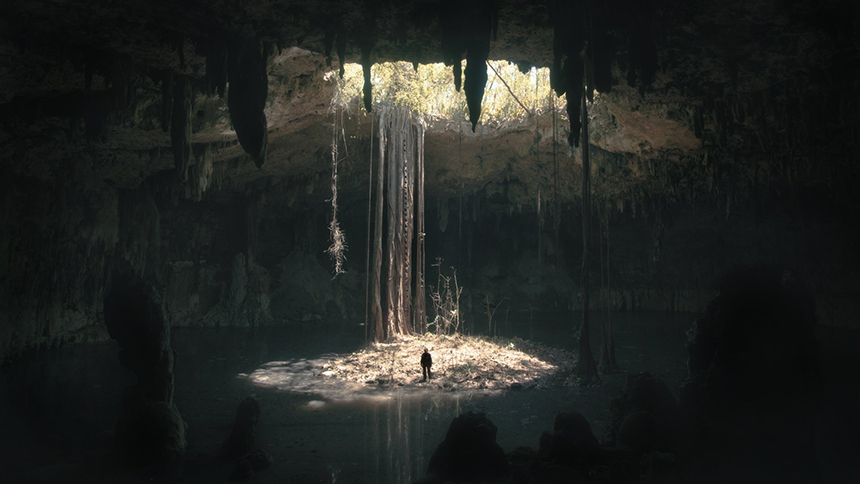Tribeca 2025 Review: In UNDERLAND, Experience Deep Time
Robert Petit loosely adapts the best selling non-fiction by Robert Macfarlane.

Caves, underground waterways, mines, catacombs, scientific labs are some of the locations featured in Robert Macfarlane's bestselling non-fiction book, Underland.
His prose, at once scientific, lyrical and philosophical, has been an open invitation and demystification of 'the awful darkness inside the world'. Traveling through the dizzying expanse of geologic time, the book is a revelatory dive into deep time, a contemplation of our fear of the dark void, reflection of a paralleled world underneath, the myths and memories, and our deep connections to the unseen environment.
Underland happens to be one of my all-time favorite books. So, when it was announced that Robert Petit, a visual collaborator of MacFarlane -- they did a short film together, Upstream, which features an aerial view of the Cairngorms Mountains and River Dee of Scotland -- would be directing, it became one of my most anticipated films to see this year.
Narrated by actress Sandra Hüller, whose clear and calm voice is a great match for the material, and voiced by archeologists, urban explorers and scientists, the film takes liberty from the book and sets this visual poem in three different locations in five chapters: a cenote and its labyrinthine cave systems in Mexico; underground storm drains in Las Vegas; and a science laboratory two kilometers underneath the Canadian Rockies. Each location invokes heady metaphors, myths, and a human connection with our surroundings.
The film starts with grainy, black and white pictures of an ancient ash tree, just like how the book starts. The ash tree is located in Mendip Hills of Somerset, where Macfarlane's childhood was spent. Beneath the tree presents the subterraneous passage into the underworld cavern.
Following Fatima Tec Pool, a Mexican archeologist and her team, into the 'entrance to the underworld', an elaborate cave system where her Mayan ancestors congregated, Petit and his team -- cinematographer Ruben Woodin Dechamps and producer Lauren Greenwood -- crawl through the rocky, slimy, dark limestone caverns. With all their modern equipment, the archeologists wonder aloud how it must have been with Mayan explorers with only torches some thousands of years ago. For Pool, it's a personal journey to connect with her Mayan ancestors, who treated the caves as a sacred place.
We are introduced to urban explorer Bradley Garrett, who descends into the storm drain system under the Las Vegas Strip. He explains the smell and texture of the system, a distinct sensory experience in an Anthropocene age. All these will be future caves, the remnants from our current civilization, he muses. There's a cryptic note on the concrete wall, warning about the rise of the water level when it rains.
Garrett witnesses the remnants of life in the drain system. People live down there: the undesirable, unseen people above ground making their way down to escape from the elements, even if that means risking drowning when the system is flooded. It's not only humans, but underland is also filled with discarded materials: cars, washing machines, and everything our modern world wants to get rid of and make it out of sight.
Then there is Mariangela Lisanti, a theoretical physicist who is in search for Dark Matter, an unseen material that consists of 65 percent of all of our universe. As a child, she looked up at the starry sky, wondering what we are made of.
Lisanti and her colleagues find a suitable space to test, in which dark-matter particles bump into target material and scatter off atomic nuclei, resulting in a measurable nuclear recoil, two kilometers down in an underground laboratory, away from elements and noises. She knows well that her experiments might not result in finding the existence of Dark Matter in her lifetime. Nevertheless, she perseveres, with her childlike curiosity and wonder intact.
Petit and his team capture some glorious images of the subterranean world, conjuring not only the physical but also the spiritual side of our understanding of the hidden world. The past, present and future mingle seamlessly as a sensory experience.
As Pool's team reaches the end of the cave, they discover the ancient palm prints left on the wall by Maya people thousands of years ago. She stretches her hand to meet the old palm prints and, in that stillness and silence, deep down underground, we experience deep time.
Underland might be short on the political urgency in nature preservation of Macfarlane's book, but it is at once sensorial, philosophical experience to be had, preferably in a darkened theater.
Underland enjoys its world premiere at Tribeca Festival and will also play at DC/Dox on June 12.
Dustin Chang is a freelance writer. His musings and opinions on everything cinema and beyond can be found at www.dustinchang.com
Underland
Director(s)
- Rob Petit
Writer(s)
- Robert Macfarlane
- Rob Petit
Cast
- Sandra Hüller







